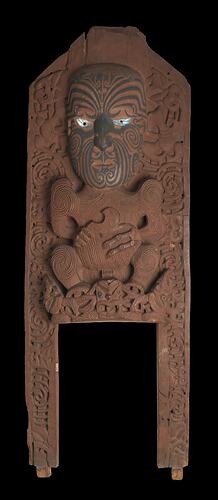Summary
In pre-European times the pataka (raised storehouse) was the most prominent feature of a Maori village. Their decorative exteriors represented the status and wealth of a tribe. Pataka stored preserved foods as well as tools, clothing and vessels. These storehouses also held the personal possessions and provisions of a chief. During the late 19th century, pataka became obsolete with the emergence of new large meeting houses.
This carving would have been the central piece of several panels used to decorate the front wall of a pataka. This panel is known as the kuaha (entranceway). It is carved in the Te Arawa style of the late 19th century. Te Arawa, a tribe from the North Island of New Zealand, employed a carving technique in this period that was distinguished by the use of deep sculptural relief. The figure depicted in this carving has paua shell (Haliotis sp.) eyes and a moko (facial tattoo) enhanced with black pigment. It is likely that it represents a tribal deity.
Local Name
Kuaha
Physical Description
A large rectangular board made from a single piece of hardwood with a section removed from the bottom half. It is carved with a central anthropomorphic figure with an exaggerated face painted with tatoo-like features in black pigment and inlaid with shell for the eyes. The figure is surrounded by abstract figurative elements.
Significance
This kuaha is from a pataka or door set at the entranceway to a Maori store house. It is carved in the Te Arawa style of late nineteenth century.
More Information
-
Object/Medium
Architectural feature
-
Maker
-
Locality
-
Date Produced
-
Date Collected
-
Object Measurements
1765 mm (Length), 625 mm (Width), 190 mm (Height)
-
Keywords
-
Collection Names
-
Type of item
-
Discipline
-
Category
-
Collecting Areas
-
Technique
Carving
-
Support
Wood
